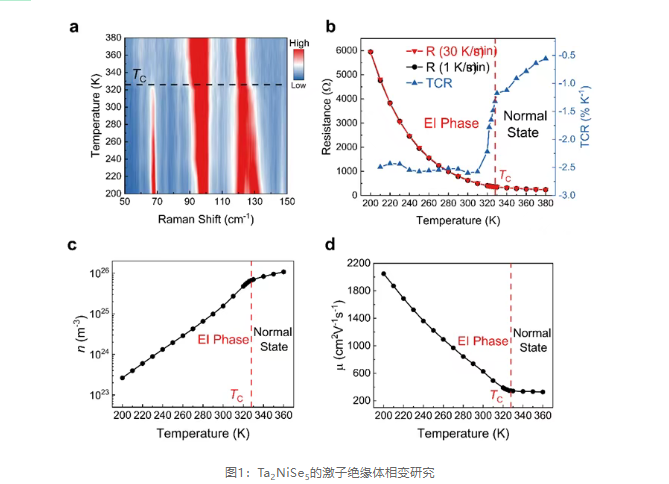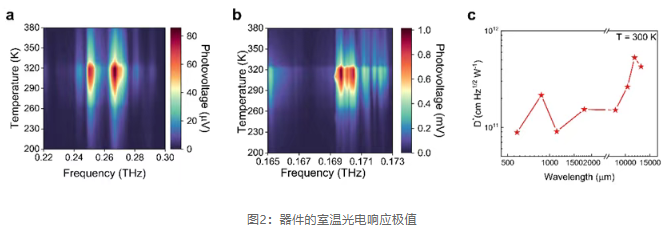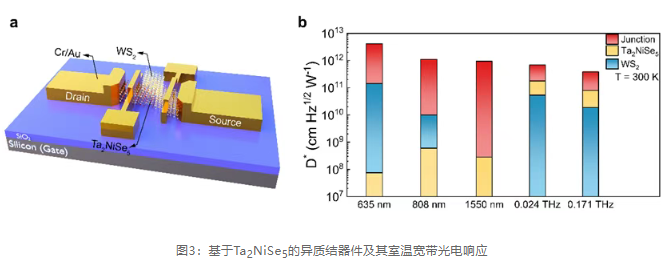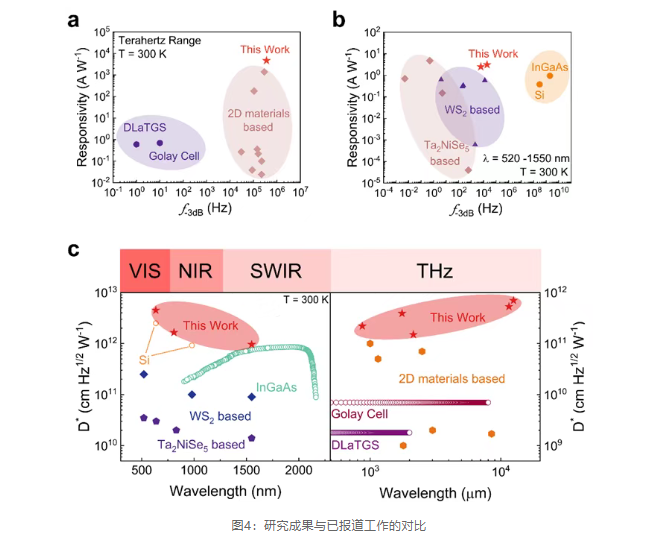14
2025
-
07
Ultrasensitive room-temperature extreme photoelectric response achieved
Author:
Recently, a research team from the Shanghai Institute of Technical Physics, Chinese Academy of Sciences innovatively utilized the electromagnetically induced potential well (EIW) effect and exciton insulator (EI) phase transition to achieve optimized photoelectric response extrema under room temperature conditions. In the terahertz band, it exhibited room-temperature high-performance response with an order of magnitude improvement in detectivity compared to traditional commercial Golay cell detectors. The research, through the synergistic regulation of exciton insulator phase transition and band engineering, provides a new paradigm for developing high-performance room-temperature photodetectors.
The relevant findings were recently published Light: Science & Applications , titled “ Ultrasensitive photoelectric detection with room temperature extremum ”, National Key Laboratory of Infrared Science and Technology Dr. Wu Tunchan is the first author of this paper, Researcher Huang Zhiming is the corresponding author of this paper.
Research Background
Room-temperature photoelectric detection shows extremely important and widespread application prospects in many fields, including imaging, quantum information, communication, and wearable electronic devices. In the development of detection technology, materials with phase transition characteristics have always been the core focus of detector research. Materials near their phase transition temperature often exhibit unique electronic and photonic behaviors, providing important opportunities for technological innovation. However, the operating temperature of such detectors is limited by the inherent phase transition temperature of the material; their optimal operating temperature is often in the low-temperature range, such as SIS mixers and TES detectors based on superconducting phase transitions. In addition, although the phase transition temperature of some materials is near room temperature, such as VO x with Mott phase transition and BST with ferroelectric phase transition, radiometers and pyroelectric detectors based on these materials can operate at room temperature, but due to the inherent limitations of their thermal effect detection mechanism, they usually exhibit low response speed and limited electrical bandwidth characteristics. Therefore, research on high-sensitivity photoelectric detection technology optimized for room temperature conditions is crucial for promoting the development of room-temperature optoelectronic technology.
Research Highlights
The research team characterized the lattice distortion of EI phase transition Ta 2 NiSe 5 through variable-temperature Raman spectroscopy ( Figure 1a ), and obtained the abrupt change in the temperature coefficient of resistance α value from -1.3% to -2.5% after the phase transition temperature of 326 K through variable-temperature electrical studies ( Ta 2 NiSe 5 Figure 1b ). Variable-temperature Hall characterization further showed that due to exciton condensation, the carrier concentration decreased rapidly and the mobility increased rapidly after the phase transition ( Ta 2 NiSe 5 Figure 1c and d ), revealing the physical essence of the abrupt change in electrical properties caused by the drastic change in transport properties due to electron-phonon coupling. This research team conducted research on the variable-temperature photoelectric response characteristics of the device, utilizing the electromagnetically induced potential well (EIW) effect and the abrupt change in transport properties under EI phase transition,

achieving an unusual room-temperature photoelectric response extremum in the terahertz band that is consistent with theoretical derivation ( Figures 2a and b ). Through further research on the variable-temperature noise and variable-temperature response time of the device, room temperature was determined as the optimal operating range for the device. As shown in Figure 2c , the detectivity of the detector in the 500-15000 μm wide-spectrum terahertz band is two orders of magnitude higher than the 7.0 × 10 cm Hz 9 W 0.5 -1 characteristic D value of the commercially available room-temperature terahertz detector Golay Cell. *值提升了2个数量级。 The research results demonstrate that Ta 2 NiSe 5 is a very promising candidate for room-temperature high-sensitivity detection.

In addition, the research team built a Type I heterojunction based on Ta 2 NiSe 5 and WS 2 , which reduced the dark current while improving the gate control capability of the device. The heterojunction device exhibited a significant photovoltaic effect at visible and infrared wavelengths and achieved a photoelectric response in the terahertz band through the synergistic effect of the EIW effect and junction effect. As shown in Figure 3 , the heterojunction device achieved more than two orders of magnitude improvement in room-temperature value of the commercially available room-temperature terahertz detector Golay Cell. * at visible and infrared wavelengths, and the terahertz band performance was also further improved.

The research team in Figure 4 compared the research results with previously reported work. In the terahertz band, the Ta 2 NiSe 5 room-temperature responsivity, electronic bandwidth, and value of the commercially available room-temperature terahertz detector Golay Cell. * of the base detector in this paper are significantly superior to commercial devices and reported terahertz detectors of two-dimensional materials . At visible to infrared wavelengths, the Ta 2 NiSe 5 based detectors in this paper The room-temperature responsivity surpasses that of commercial infrared detectors and reported 2D material detectors. Simultaneously, its room-temperature electronic bandwidth shows a significant improvement compared to most reported 2D material detectors. . value of the commercially available room-temperature terahertz detector Golay Cell. * Compared to reported Ta 2 NiSe 5 and WS 2 -based two-dimensional material detectors, the detector has achieved a 1-2 order of magnitude improvement at room temperature and can rival the room-temperature performance of commercial detectors.

This study, for the first time, achieves ultra-sensitive photoelectric response regulation optimized for room temperature conditions through electromagnetically induced potential well effects and exciton insulator phase transition characteristics. By synergistically regulating the exciton insulator phase transition and band engineering, this research provides a new paradigm for developing high-performance room-temperature photoelectric detectors. The achieved ultra-sensitive detection characteristics in the visible light-infrared-terahertz wide spectral range at room temperature demonstrate significant application potential in cutting-edge fields such as environmental monitoring and remote sensing imaging, marking a crucial step towards practical applications of quantum phase transition materials in the field of optoelectronic information.

